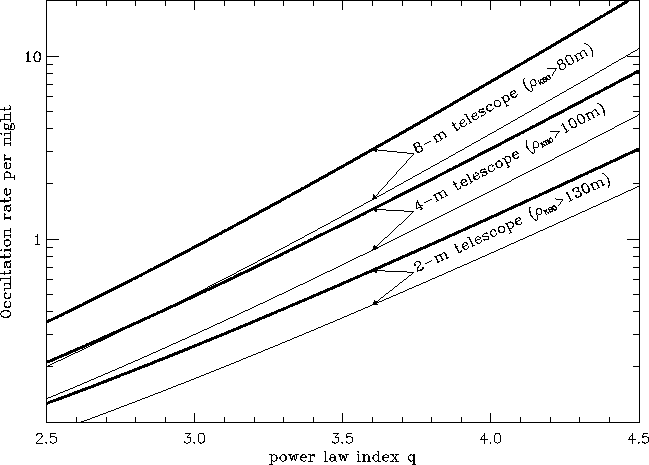| (15) |
| (15) |
For ![]() second, the r.m.s. fluctuations on a 2.-m class telescope is roughly
second, the r.m.s. fluctuations on a 2.-m class telescope is roughly
![]() for optimal conditions.
According to Table I, this will allow us to detect (at
for optimal conditions.
According to Table I, this will allow us to detect (at ![]() ) sub-kilometer
objects. The largest ground-based telescopes (i.e. the 10-meters
class telescopes) allow us to marginally reach
) sub-kilometer
objects. The largest ground-based telescopes (i.e. the 10-meters
class telescopes) allow us to marginally reach
![]() and then
to detect about 40m radius KBOs (see Table I).
and then
to detect about 40m radius KBOs (see Table I).
Some useful results, concerning the 2.-, 4.- and 8.-m class telescopes when
observing O5 class stars for two magnitudes (12 or 10), are summarized on
Fig.4, where we have plotted the occultation rates per night as a
function of the power law index q of the sub-kilometer KBO size
distribution (with ![]() for
for ![]() km as in Table II).
We have also indicated on this figure, for each telescope diameter, the
approximate radius of the smallest KBO detectable with the considered
telescope. In each case,
km as in Table II).
We have also indicated on this figure, for each telescope diameter, the
approximate radius of the smallest KBO detectable with the considered
telescope. In each case, ![]() is computed for optimum
observing conditions, i.e. O5 stars, observed from good sites, in the ecliptic and
at the opposition, with telescopes equipped with a sufficiently rapid
photometer (at least 20Hz).
Figure 4 shows that
is computed for optimum
observing conditions, i.e. O5 stars, observed from good sites, in the ecliptic and
at the opposition, with telescopes equipped with a sufficiently rapid
photometer (at least 20Hz).
Figure 4 shows that ![]() increases exponentially with q
but this variation also strongly depends on observational circumstances:
We may thus expect that an observation campaign on various sites
and/or with different instruments and/or observing different stars
could provide by cross-checking a good estimation of q concerning these elusive
small KBOs.
One can also see on Fig.4 how much the choice of the star is important for
implementing the search for occultations by KBOs: For example, the
decrease in occultation
rate is roughly the same when passing from a 8-m to a 4-m telescope
with an O5 star of 12th magnitude as when passing from a 12th to the 10th
magnitude O5 star with a 8-m telescope.
increases exponentially with q
but this variation also strongly depends on observational circumstances:
We may thus expect that an observation campaign on various sites
and/or with different instruments and/or observing different stars
could provide by cross-checking a good estimation of q concerning these elusive
small KBOs.
One can also see on Fig.4 how much the choice of the star is important for
implementing the search for occultations by KBOs: For example, the
decrease in occultation
rate is roughly the same when passing from a 8-m to a 4-m telescope
with an O5 star of 12th magnitude as when passing from a 12th to the 10th
magnitude O5 star with a 8-m telescope.
 |
Let us finally remark that, in the tables I and II, the
![]() case is unreachable from the ground, but might be achievable in space,
if we get fast enough photometry on such space facilities
(present or future). In this case, the number of occultations could be indeed
spectacular and decisive for our knowledge of the Kuiper belt size
distribution.
case is unreachable from the ground, but might be achievable in space,
if we get fast enough photometry on such space facilities
(present or future). In this case, the number of occultations could be indeed
spectacular and decisive for our knowledge of the Kuiper belt size
distribution.